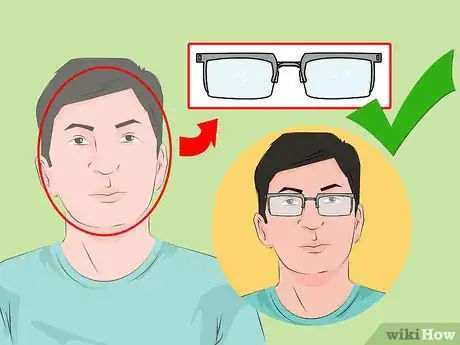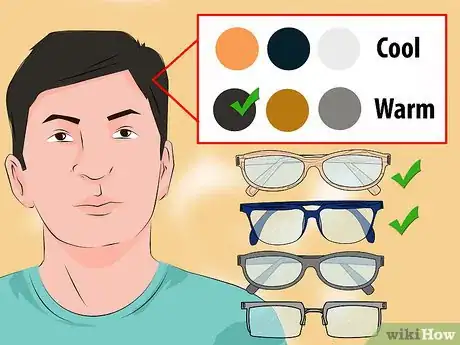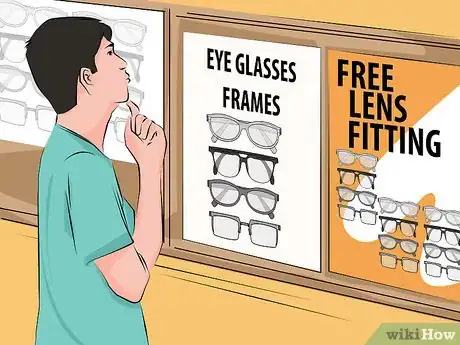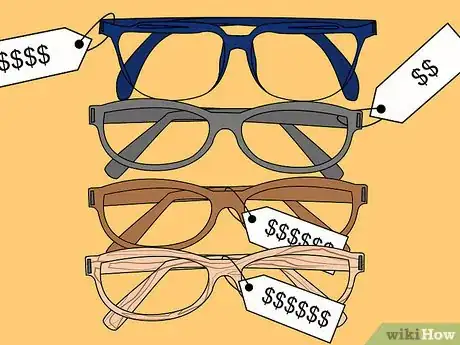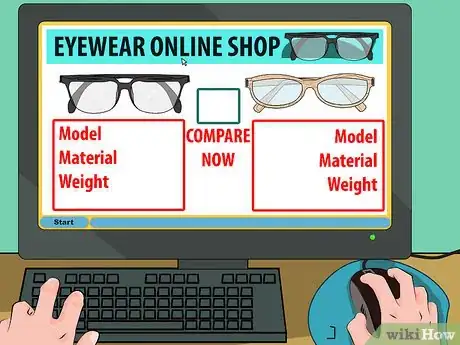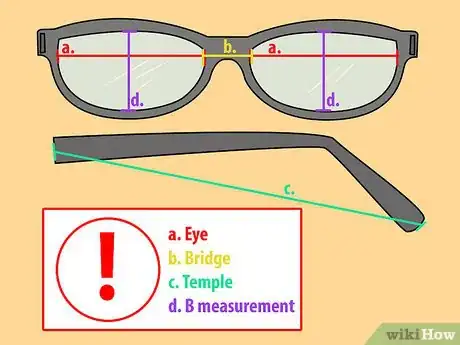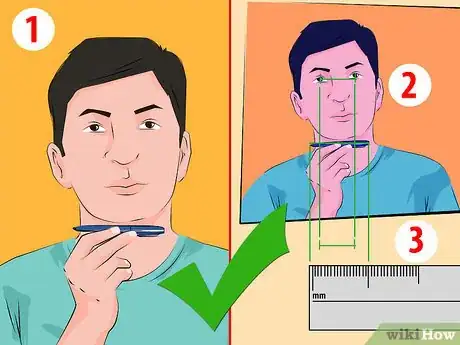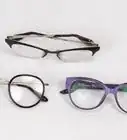This article was co-authored by Alexander Knezevic, MD. Dr. Alexander Knezevic is an Ophthalmologist at the Macy Eye Center in Los Angeles, California. He also is Medical Staff at Cedars-Sinai Medical Center and is a Clinical Instructor of Ophthalmology at UCLA. He graduated with his Doctor of Medicine degree from the University of Nebraska Medical Center, and he completed his Residency at the McGaw Medical Center of Northwestern University. Dr. Knezevic did his Fellowship at the University of California-Irvine, and he’s board certified by the American Board of Ophthalmology. Additionally, Healthgrades has awarded him their Honor Roll award.
This article has been viewed 270,190 times.
Choosing a pair of frames is an important part of matching your eyewear to your personality and lifestyle. In the twenty first century, there are a variety of sources you can choose from. Your optometrist will be able to offer the most tailored fit, but they may not have frames you love. Other sellers may also be able to significantly undercut the price of your optometrist. Before you go shopping, however, you need to determine the shape, size, color, and material of your frames.
Steps
Determining Practicality
-
1Think about how often you wear glasses. This has an effect on several aspects of your new frames. People who wear glasses less often probably want to spend less money. They may also be okay with heavier frames. Those who wear glasses regularly may want to spend more money on a more durable pair. They might also want lighter, more practical frames.
-
2Think about your daily lifestyle. Some of your daily activities may call for special features. Proximity to water, activity, and machinery will affect which frames you select. If you wear your glasses during manual labor, look at the glasses of those around you. The common denominator between your coworkers’ frames may give you an idea as to what works best in your job.[1]
- Those who are active throughout the day should look into break and scratch resistant frames. This will minimize how often you have to get the frames repaired. It is also advisable that you pick frames with a warranty. Free or discounted repairs are a must for the active glasses wearer.
Advertisement -
3Determine how nice you want them to look. Think about how you will use your glasses. Some emphasize practicality and price over style. Others will use their glasses in professional or social situations that call for more sleek or stylish frames. The minimalistic pairs will cost you less, but the more fashionable are more likely to accentuate your face and outfit.
Accentuating Your Features
-
1Determine your face shape. Picking the most ideal frame for your face is not entirely up to you. Much is dictated by the natural features of your face. The most important aspect of this is your face shape. You can easily figure this out by looking in the mirror or taking a picture, and comparing it to a diagram.[2]
- Round face. With this shape, look into more toward square and rectangular frames that will make your face look slimmer and longer. Avoid frameless, oval, and circular frames.
- Oval. Pick frames with a strong bridge, and avoid large frames that will make your face look small.
- Square. To offset the angularity of your face, tend toward rounded or round frames.
- Diamond. You may not want to accentuate your narrow forehead, so don’t pick wide frames that call attention to this. Opt instead for small, rounded frames.
- Heart. To minimize how large your forehead appears compared to your chin, pick frames that sit low on the nose. This makes the center of your face seem lower.
-
2Figure out skin allergies. If this is not your first pair of frames, you probably have an idea of your skin allergies. Otherwise, your dermatologist can give you a test to determine this. If you are unsure and don’t want a test, there are materials that are more likely to break out your skin than others.[3]
- Plastic or synthetic. These frames are often designed to be hypoallergenic, meaning they are less likely to break out your skin. They also have a wide price range. A few examples are cellulose acetate/zylonite, cellulose propionate, and nylon.
- Metal. Metal frames vary, as far as skin allergies are concerned – some are hypo-allergenic, but others may break you out. Examples are titanium, stainless steel, beryllium, and aluminum.
- Other/natural materials. Wood, bone, and horn do not usually cause skin allergies.
-
3Look at your skin tone. Most people fit into two basic categories for skin tone. To figure out if you have warm or cool skin tone, hold up a piece of white paper next to your face. If your skin seems yellowish, brownish, or bronze, you have a warm skin tone. If your skin seems pinkish or bluish, you have cool skin tone.[4]
- For warmer skin tones, stick with tortoise, browns, and dark green over white, black or pastel colors that contrast heavily.
- For cooler skin tones, look for more stark colors like black, white, and bright colors. The more brownish hues will contrast with your skin tone.
-
4Consider your hair color. This is similar to your skin – there are two main categories of hair tones. Some cool hair colors are strawberry-blonde, blue-black, and white. Examples of warmer hair colors are brownish-black, golden blonde, and gray. Apply the same rules for frame color as with your skin tone. If your hair color and glasses frames don't look good together in the optical, then you will hate the glasses at home!
Buying Frames in a Shop
-
1Figure out your optometrist’s rates for fitting your lenses. Some optometrists feature frames in their office. They may fit your lenses in these for free or at a discounted rate. Before shopping around, you should know if their rate for bringing in an outside pair of frames will put the glasses out of your price range.
-
2Look at optometrist’s prices for frames. It seems that the best prices will be at specialty or discount frames shops. However, you may find that the difference between these shops and your optometrist is negligible. After the fee for fitting your lens, warranties, and other considerations, you may be better off picking frames from your optometrist.[5]
- If you only use your glasses minimally and at home, you may not feel the need to have a big insurance plan. Determine if you need to be able to get your frames repaired for free when comparing costs.
-
3Look at other eye-care centers in the area for frames. There may be specialty frame shops that sell products much different than those offered by your optometrist. They may also be discounted enough that it vastly outweighs the benefits of picking a pair in your optometrist’s office. Don’t limit yourself to the prices and stock of one shop when picking out new frames.
Ordering Frames Online
-
1Look at materials, size, weight, and features. Without an optometrist or impartial observer around, you need to pay close attention to the frames’ specifications. In addition to looking at its special features, material, and size, look at the weight. Without the ability to try on glasses you find online, you will have to compare their specifications with glasses lying around the house. Weigh your old glasses using a mini scale and use it to gauge the relative weight of frames you find online.[6]
-
2Know your measurements. It is important to get frames that will fit the anatomical features of your face. Even a pair of glasses that is the right total width and height may still not fit your face. Make sure all the measurements are right for your face by taking a pair of glasses you have on-hand and using its measurements to determine the relative size of a pair online. These measurements are generally in millimeters.[7]
- Eye. This is the width of each lens, from its outermost points.
- Bridge. This is how far apart each lens is.
- Temple. This is the length of the piece that tucks behind your ear.
- B measurement. This is the height of each lens, measured from its highest and lowest points.
-
3Measure your pupillary distance (PD). This is the distance between your pupils. Since it is difficult to measure on your own, the way to get the most accurate PD is to have your optometrist measure it for you. However, there are ways you can ‘do it yourself’ at home. This might save yourself time and get a general idea of what range of PD sizes you fall into. This number is generally measured in millimeters.[8]
- The easiest way to measure PD at home is with a picture. Hold an item you know the dimensions of (like a pen) directly under your chin. Take a picture in the mirror and get out a ruler. For example, if the pen was 5” (or 127 mm) long, and appears 1” (25.4 mm) long in the photo, you know the ratio of photo measurements to actual measurements is 1:5. So, if your pupil distance was a half inch in the photo, we multiply that by 5. This number gives us the pupillary distance – 2.5”, or 60mm.
-
4Look at the store’s policies. You want to be able to try the glasses on and return or exchange them for free. Also take into consideration how this will affect your bottom line price, especially with shipping charges. You should look for a seller that offers some kind of warranty, insurance, and maintenance guarantee.
-
5Try them on and consider returning them. This is the most important aspect of buying glasses online. It is impossible to be as accurate with your own measurements choosing a pair online as a pair tailored for you by your optometrist. The online seller may also have misleading or inaccurate pictures or specifications. Wear them for a day or so, and think about your levels of comfort and vision.
References
- ↑ https://www.vsp.com/how-to-choose-glasses.html
- ↑ https://www.vsp.com/how-to-choose-glasses.html
- ↑ http://www.allaboutvision.com/eyeglasses/eyeglass_frame_materials.htm
- ↑ https://www.vsp.com/how-to-choose-glasses.html
- ↑ https://www.allaboutvision.com/eyeglasses/average-eyeglass-cost/
- ↑ https://opticianworks.com/the-consumers-guide-10-11-15/
- ↑ https://www.allaboutvision.com/en-in/eyeglasses/faq/eyeglass-sizes/
- ↑ https://opticianworks.com/the-consumers-guide-10-11-15/
About This Article
To choose glasses frames that look good on you, first consider your face shape. For example, if you have a round face, try square frames to make your face look slimmer. Similarly, if you have an oval face, try choosing smaller frames with a strong bridge to even out the size of your face. Don’t worry if you can’t find frames you like at the optometrist; many websites also sell frames, and you can search online for a pair you’ll feel confident in. For tips on choosing glasses frames that look great with your skin tone and hair, read on!



